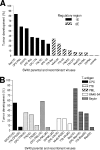Influence of the viral regulatory region on tumor induction by simian virus 40 in hamsters
- PMID: 17977966
- PMCID: PMC2224577
- DOI: 10.1128/JVI.01626-07
Influence of the viral regulatory region on tumor induction by simian virus 40 in hamsters
Abstract
Most of the simian virus 40 (SV40) genome is conserved among isolates, but the noncoding regulatory region and the genomic region encoding the large T-antigen C terminus (T-ag-C) may exhibit considerable variation. We demonstrate here that SV40 isolates differ in their oncogenic potentials in Syrian golden hamsters. Experimental animals were inoculated intraperitoneally with 10(7) PFU of parental or recombinant SV40 viruses and were observed for 12 months to identify genetic determinants of oncogenicity. The viral regulatory region was found to exert a statistically significant influence on tumor incidence, whereas the T-ag-C played a minor role. Viruses with a single enhancer (1E) were more oncogenic than those with a two-enhancer (2E) structure. Rearrangements in the 1E viral regulatory region were detected in 4 of 60 (6.7%) tumors. Viral loads in tumors varied, with a median of 5.4 SV40 genome copies per cell. Infectious SV40 was rescued from 15 of 37 (40%) cell lines established from tumors. Most hamsters with tumors and many without tumors produced antibodies to T antigen. All viruses displayed similar transforming frequencies in vitro, suggesting that differences in oncogenic potential in vivo were due to host responses to viral infection. This study shows that SV40 strains differ in their biological properties, suggests that SV40 replicates to some level in hamsters, and indicates that the outcome of an SV40 infection may depend on the viral strain present.
Figures



References
-
- Ahuja, D., M. T. Sáenz-Robles, and J. M. Pipas. 2005. SV40 large T antigen targets multiple cellular pathways to elicit cellular transformation. Oncogene 247729-7745. - PubMed
-
- Butel, J. S. 2000. Viral carcinogenesis: revelation of molecular mechanisms and etiology of human disease. Carcinogenesis 21405-426. - PubMed
Publication types
MeSH terms
Substances
Grants and funding
LinkOut - more resources
Full Text Sources

